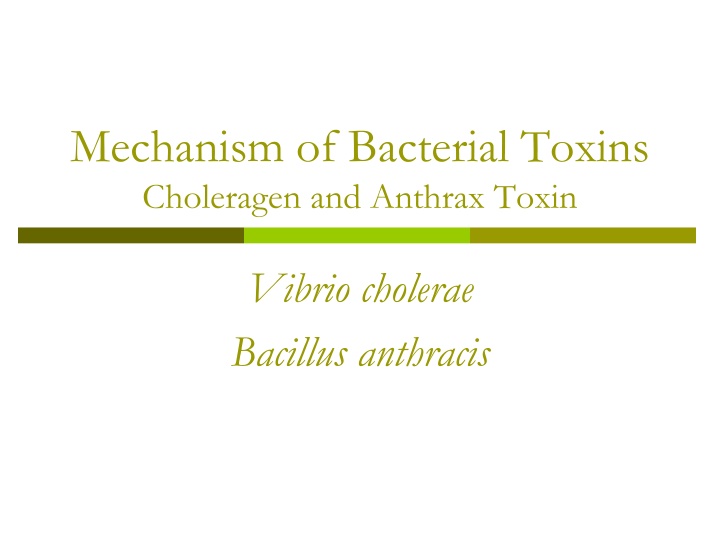
Mechanism of Bacterial Toxins: Cholera and Anthrax Insights
Explore the mechanisms of bacterial toxins produced by Vibrio cholerae and Bacillus anthracis, their symptoms, and actions. Understand how cholera toxin affects adenylate cyclase and how anthrax exotoxin works. Learn about Vibrio cholerae's serotypes and associated symptoms.
Download Presentation

Please find below an Image/Link to download the presentation.
The content on the website is provided AS IS for your information and personal use only. It may not be sold, licensed, or shared on other websites without obtaining consent from the author. If you encounter any issues during the download, it is possible that the publisher has removed the file from their server.
You are allowed to download the files provided on this website for personal or commercial use, subject to the condition that they are used lawfully. All files are the property of their respective owners.
The content on the website is provided AS IS for your information and personal use only. It may not be sold, licensed, or shared on other websites without obtaining consent from the author.
E N D
Presentation Transcript
Mechanism of Bacterial Toxins Choleragen and Anthrax Toxin Vibrio cholerae Bacillus anthracis
Vibrio cholera Vibrio cholerae is a gram-negative, comma-shaped rod belonging to the family Vibrionaceae. Its natural habitat consists of fresh-water and salt-water environments. Based on differences in the composition of the major cell wall antigen (O), 139 serotypes have been differentiated.
Vibrio cholerae, which belongs to either serogroup O1 which is responsible for the seventh cholera pandemic, is divided into three serotypes, Inaba, Ogawa and Hikojima (a variant of the Ogawa serotype) , or serogroup O139, has been associated with epidemic cholera.
Vibrio cholerae Vibrio cholerae Produces A + 5B exotoxin Gram negative vibrio Unusual disease Cholerae does not invade tissue Cholerae does not damage tissue Lives in estuaries on copepods Humans are incidentally infected when ingesting contaminated food or water
Symptoms of Vibrio cholerae Symptoms Secretory or watery diarrhea No blood in diarrhea Large watery bowel movements Loss of electrolytes Muscle cramps Low blood pressure Rapid heart rate & feeble pulse Vomiting White blood cell count usually normal Treatment Usually self limiting symptoms as long as IV fluids are administered with oral rehydration solutions
Mechanism of Action of cholerae toxin Normally Adenylate cyclase (AC) enzyme which makes cAMP Epithelial cells secrete digestive fluid (HCO3-) in response to small increases in cAMP levels cholerae exotoxin ADP ribosylation of G-protein Over activation of AC Causes 100X increase in cAMP Causes huge amounts of water and Cl- to leave via channels
Bacillus anthracis Bacillus anthracis Produces 2A + B exotoxin Gram positive spore forming bacteria Found in soil Anthrax disease direct exposure to spores Inhalation pulmonary Ingestion gastrointestinal Invasion into surface wound cutaneous No cases involve person to person spread
Symptoms of Bacillus anthracis Cutaneous Spores enter abrasions or cut in skin Germination of spore causes local ulceration of the skin Painless black eschar with edema Antibiotics prevent invasion into blood stream Usually heals completely without scarring
Symptoms of Bacillus anthracis Pulmonary Life cycle Macrophages engulf spores Travel to nodes Spores germinate en route Cells are released spreading toxins and vegetative cells into the blood stream Symptoms caused by toxins Fever and chills Shortness of breath, & cough Massive pleural effusions Sepsis, shock & death
Mechanism of Action of anthracis Toxins Two primary toxins & capsule gene All three genes are located on plasmids Edema Factor A toxin Adenylyl cyclase enzyme increase in cAMP Causes edema and pro-inflammatory response Lethal Factor A toxin Metalloprotease Cleaves MAP kinase (Mitogen Activated Protein kinase) required from cell division and signaling Causes an overall suppression of immune system
Mechanism of Action of anthracis Toxins EF LF EDEMA B Increased expression of pro-inflammatory mediators EF cAMP Endosome B Acidic Environment MAPK IMMUNE SUPPRESSION WBCs do not divide in the presence of pathogens; overall decrease in phagocytosis
Normal Signaling Pathway Adenylate Cyclase Receptor GDPGTP cAMP P PKA Catalytic Subunit PKA Regulatory Subunit Leads to a temporary increase in pro-inflamatory proteins and an overall activation of the immune system. Nucleus
Mechanism of Action of Edema Toxin Cell Membrane toxin has already entered through RME Over expression of cAMP by edema factor A EF PKA Catalytic Subunit cAMP P Results in overall systemic edema Leads to an abnormal increase in pro-inflamatory proteins, increased capillary permeability & decrease in phagocytosis Nucleus
Intracellular Signaling Pathways Terms Adenylate Cyclase (AC) Membrane enzyme which makes cAMP cAMP Inracellular second messenger Binds to the regulatory subunit of PKA and releases an active catalytic subunit G proteins A group of proteins which activates AC When GDP is bound not active When GTP is bound is active short lived GTP is self hydrolyzed by the G protein back to GDP This ensures that the levels of cAMP are tightly regulated Exchange of GDP to GTP requires hormonal activation
Intracellular Signaling Pathways Terms PKA protein kinase A Enzyme which phosphorylates (P) other proteins Phosphorylation activates some proteins Phosphorylation inactivates other proteins Transcription Factor DNA binding protein which binds to genes to increase or decrease the amount of gene expression In some cases phosphorylation (P) is necessary for the transcription factor to bind DNA
Mechanism of Action of Lethal Toxin Cell Membrane toxin has already entered through RME LF Protease Needed for cell division of WBCs during an immune response MAP Kinase Needed for expression of TNF Tumor necrosis factor which increases chemotaxis and phagocytosis Due to LF protease activity MAP kinase is not active and normal cellular responses are lost Degraded MAP kinase Protein






















